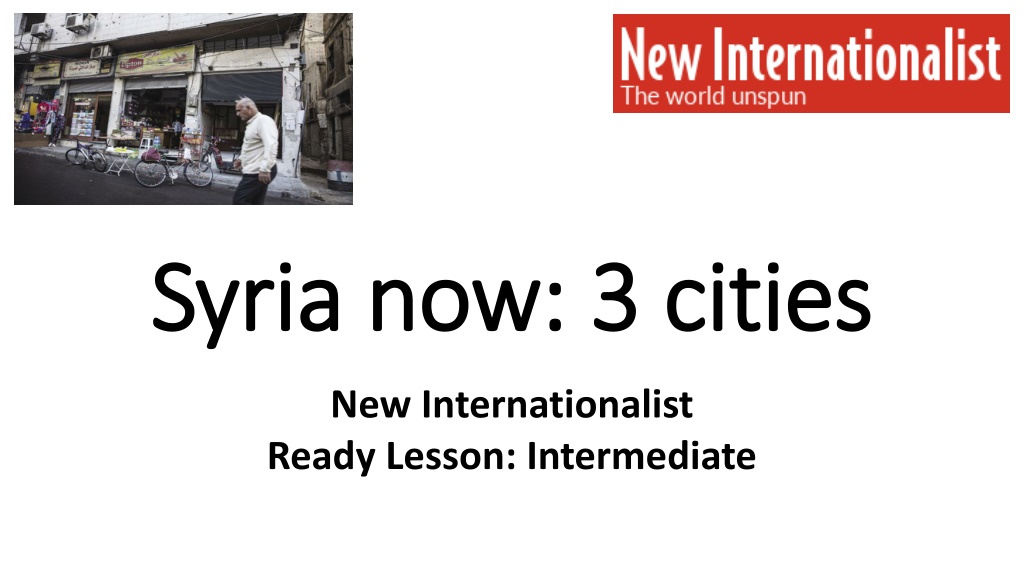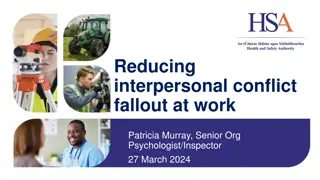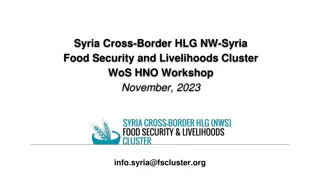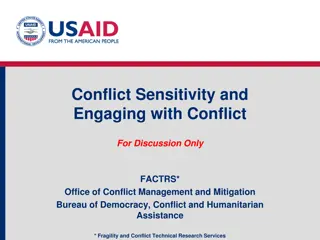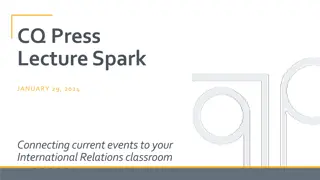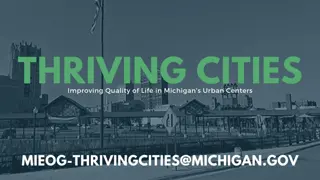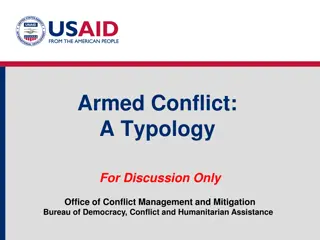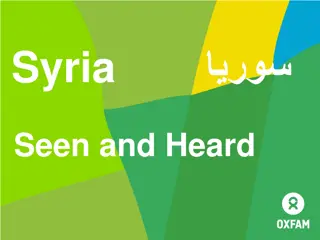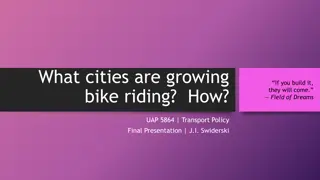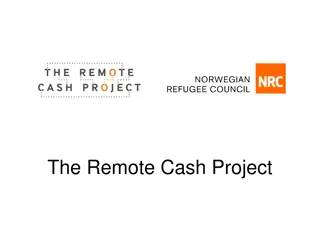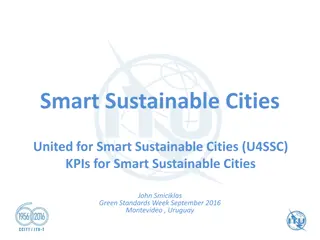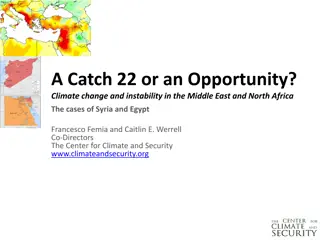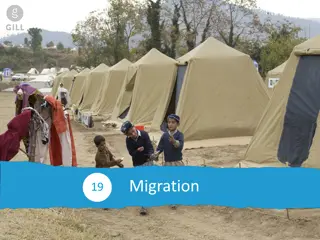Explore Syria: Cities in Conflict
Delve into the realities of Syria through descriptions of its cities at war, where bombings interrupt daily life and affect the economy. The impact of the conflict is evident in the shifting population and heightened security measures. Discover how the war has shaped the landscapes and livelihoods of the people in these urban centers.
Download Presentation

Please find below an Image/Link to download the presentation.
The content on the website is provided AS IS for your information and personal use only. It may not be sold, licensed, or shared on other websites without obtaining consent from the author. Download presentation by click this link. If you encounter any issues during the download, it is possible that the publisher has removed the file from their server.
E N D
Presentation Transcript
Syria now: 3 cities Syria now: 3 cities New Internationalist Ready Lesson: Intermediate
This lesson: Speaking and writing about photos Reading, matching and discussing descriptions Comparing simplified English with the original and learning new phrases/words Writing: an article or a poem
How much do you know about Syria? How much do you know about Syria? What do you think the following are like: The buildings The animals and birds The people The shops How has the war affected everything?
In pairs, speak to each other and describe what you see in this picture: Picture 1 Picture 1:
Now describe this picture in writing: each person writes 2 or 3 words, then passes on the paper to another person to continue: Picture 3: Picture 3:
Now read 3 descriptions of cities: Now read 3 descriptions of cities: a, b & c and decide which picture a, b & c and decide which picture each one is talking about each one is talking about And why?
a) The bombing sounds like thunder. You can hear it as rich people here sit and eat plates of mezze and talk. You can hear it as women push prams past shops and smile at the perfume and spice sellers. In the square outside, pigeons fly away as more bombs fall in the distance. They tell people who are new to the Old City how long to count between seeing a strike and hearing it. Then they will know where it is. Five seconds for Eastern Ghouta and two for Jobar. A Ministry of Tourism official says that mortar bombs make a different noise, a sort of whistle. Mortar bombs killed at least 60 people on the government side in the two months from mid-November 2017. Activists in opposition areas say many more died in the first weeks of 2018 as a result of bombing. Since the war started, the value of the Syrian pound has gone down and so this city is more and more expensive. When there was fighting across the country, people left rural areas and went to the city. But many left again after rents became too expensive. The number of military checkpoints is going down, but this is still a city at war. They stop and search shopkeepers. Hotel staff stop you from taking photos from their roof terrace. Churches and mosques show photos of people from their congregations who have died. There are pictures of dead soldiers on walls of glory on streets, at roundabouts, or in parks. So many people have disappeared. Perhaps they are kidnapped or dead or they might come back again one day. Others are certainly alive but may never come back. Most people I met had a relative in Europe. One mother has a son who left for the UK to escape military service. She took out a photo of him and kissed it again and again. This year she ll miss another son s wedding in Sweden. Pictures of Assad are everywhere - on office walls, on shops, and on every army checkpoint. In one, he looks serious and in another, he smiles shyly in a suit. More than seven million Syrians have gone abroad and hundreds of thousands have died since the war began. But Assad is going nowhere soon. And this city is the centre of the campaign to support him.
b) Hend Joseph Fadul arrived here 65 years ago after she was married. She loved its beauty. Now she is 85 and she remembers a city of simple houses, simple streets, and old black stone. In this city, she s lived a full and happy life with her three sons, two daughters, and many grandchildren. She speaks of church and concerts, love stories and laughter. Now, all her family live in other places, her husband is dead, her apartment is destroyed, and she is very sad. She is lonely, like many of the city s elderly people. Her sons are far away in Sweden and Dubai, and one grandson is in South America. The Governor Talal Barazi says about 21,000 families, or 30 per cent of the city s former 1.2 million population, have returned. But it is impossible to live in many parts of the city. Tarek Safar is the area manager for the United Nations Development Programme in this city. He says since 2014 they ve removed 700,000 cubic metres of debris, just from the roads in the Old City and the shops in the souk. This is the only part of the city they re rebuilding. He says the government is not continuing with other rebuilding. It is waiting to decide which international organizations it will give contracts to. People expected it will give contract to its friends, Russia and Iran. As we drive through the Jouret al-Shayah neighbourhood, it is like going into a wasteland at the end of the world. In a car with two soldiers and a man from the Ministry of Information, we feel horror at how they treated people here. There are endless streets of buildings where the people were crushed. Young people here all seem to be planning to move away. One 26-year-old woman, Maria, is preparing for her wedding in Dubai and a new beginning. Her friend, Joseph, will join his brother in Canada this year. Now there are only a few old people left behind with few options. One is Hadi. He was an English teacher. He loves Shakespeare and he is helping to organise the rebuilding of the Homs city park. He s there 14 hours a day and organises student volunteers. They collected pieces of glass from broken buildings to make mosaics on the walls.
c) When I smell the smell of my neighbourhood, I feel full of energy, I feel positive about the future, Huossen Hamod says. He is 40 years old and looks nervous as he sits in an apartment on the fifth floor with almost nothing in it. From their balcony, his young girls look down at the rubble. At night, they have a light powered by their own generator. It is the only one. Hundreds of his relatives live in this neighbourhood in Ansari al-Sharki. We were famous here, he says. When there was a problem, they visited the family s most senior man. He gave his help. He died of old age during the war, far away from his home. Hamod s wife, six daughters, and one son escaped from their home in 2013, when government bombs dropped everywhere, and rebel groups began fighting among themselves. They came back in August 2017. He thinks only five people live on their street now, but neighbours don t communicate like they did before. Hamod says, This neighbourhood was used as a prison to kill and kidnap people. Hamod offers cigarettes as we sit on plastic chairs and his youngest girls look on from around a corner. He s trying to return to his job as a letting agent. Like other families slowly coming back into former rebel areas, he needed to return for financial reasons. It was too expensive to stay elsewhere. I dreamed of coming back to my home, he says. But Hamod didn t know if their building would still be there. A video from when this area was under opposition control shows a bomb falling right in front of it. A photo taken by an activist around the same time shows their fifth floor apartment as an empty shell with windows smashed by the bombs. We rebuilt all the walls and all the broken windows, Hamod says. His daughters are still frightened. The youngest was born away, in 2015, and he named her Shahiba, after this city. The second youngest was named Sham after the revolution began. I named them for Syria. UNHCR says the population of east Aleppo increased from 50,000 in December 2016 to over 300,000 by June 2017. This was after the fall of the final opposition areas, when most rebels left for the country s northwest. The UN called this a forcible displacement and a war crime.
Now youre going to compare the Easier Now you re going to compare the Easier English texts with the original texts: English texts with the original texts: Underline the differences Choose 5 new phrases or words from each original text that you want to learn Teach your new phrases / words to another learner
a) DamascusThe bombing sounds like thunder. It booms in the background as wealthy Damascenes sit in courtyards grazing on plates of mezze, continuing to chat. It sounds again as women push prams past shops in the souk, smiling at the perfumers and spice sellers hawking their wares. In the square outside, pigeons scatter as more bombs fall in the distance. Newcomers to Damascus Old City are told how long to count between seeing a strike and hearing it to figure out where it is happening. Five seconds for Eastern Ghouta and two for Jobar. Mortars make a different type of noise, a sort of whistle, a Ministry of Tourism official explains, perched in an armchair in a still open boutique hotel. At least 60 people on the government side were killed by mortars in the two months from mid-November last year, while activists in opposition-held areas say many more had already died in the first weeks of 2018 as a result of bombing. Since the conflict started, the value of the Syrian pound has plummeted, so Damascus has become increasingly expensive. When fighting spread across the country, displaced people fled from rural areas to the city, but many left again after rents became prohibitively high. The number of military checkpoints is decreasing, but Damascus remains a city at war. Shopkeepers carrying produce are stopped and searched. Hotel staff prevent you from taking photos from their roof terrace with a repetitive: It s not allowed . Churches and mosques display photos of those in their congregations who have died. Pictures of dead soldiers hang along walls of glory on streets, at roundabouts or in public parks. There are so many people whose fates are unknown. Kidnapped, disappeared or presumed dead; they still might turn up at any time. Others are certainly alive but may never come back. Almost everyone I met had a relative in Europe. One mother, whose son fled to the UK to escape military service, pulled out a photo of him from her wallet and repeatedly kissed it. This year she ll miss another son s wedding in Sweden. Pictures of Assad hang everywhere: on office walls, on shopfronts and on every army checkpoint. In one, he wears aviator sunglasses and khaki, and looks sternly off to the side. In another, he smiles bashfully in a suit. It s a reminder that he s going nowhere quickly although more than seven million Syrians have fled abroad and hundreds of thousands have died since the war began. Damascus is the centre of the propaganda campaign around him.
b) Homs: When Hend Joseph Fadul first arrived in Homs as a newlywed 65 years ago, she was struck by its beauty. Now, at 85, she remembers a city of simple houses, simple streets and old black stone. A little old woman wearing a plaited black hairband and a lime green shawl, she looks frail, yet smokes voraciously. In this city, she s lived a full and happy life; surrounded by a growing family three sons, two daughters and many grandchildren. She speaks of church and concerts, love stories and laughter. Now, her family are dispersed, her husband dead, her apartment destroyed and her spirits low. She is lonely, as are many of the city s elderly people. Her sons are as far away as Sweden and Dubai, and one grandson is in South America. Around 21,000 families, or 30 per cent of the city s former 1.2 million population, have returned according to Homs Governor Talal Barazi. Yet many parts remain uninhabitable. Tarek Safar, the area manager for the United Nations Development Programme in Homs, says since 2014 they ve removed 700,000 cubic metres of debris, just from the roads in the Old City and the shops in the souk the only part of the city they re actively rebuilding. Other reconstruction is on hold until the government decides which international organizations will get lucrative reconstruction contracts, he says. It s expected to reward its allies, Russia and Iran. Driving through the Jouret al-Shayah neighbourhood is like entering an apocalyptic wasteland. From a car, accompanied by two soldiers and a Ministry of Information employee, it s hard to feel anything but horror at how humanity was failed here. Seemingly endless streets of buildings and their inhabitants have been crushed, pounded and pulverized. A driving licence certificate lies on the ground in the rubble, close to sepia-tinged photos and a child s schoolbook. Traces of young lives once lived here are juxtaposed with the fact that young people in the populated parts of Homs all seem to be planning to move away. One 26-year-old woman, Maria, is preparing for her upcoming wedding in Dubai and a new beginning. Her friend Joseph will join his brother in Canada this year.
c) Aleppo: When I smell the smell of my neighbourhood, I feel full of energy, I feel optimistic, Huossen Hamod is saying. He s a rakish, nervous-looking 40-year-old, sitting in a fifth floor apartment with almost nothing in it. From their reinforced balcony, his young girls stare out at the rubble beneath them. At night, their light powered by their own generator is the only one that gleams. This neighbourhood in Ansari al-Sharki used to be home to hundreds of his relatives. We were famous here, he says. When there was a problem, they d visit the family s most senior man who would mediate and magistrate. He died of old age during the war, far away from his home.Hamod s family his wife, six daughters and one son escaped from their home in 2013, when government barrel bombs dropped indiscriminately, and rebel groups began fighting among themselves. They came back last August. The ruins they returned to were haunted by bad deeds, says Hamod. This neighbourhood was used as a prison to kill and kidnap people. Hamod offers cigarettes as we sit on plastic chairs, his youngest girls peeking around a corner. He s attempting to return to his work as a letting agent. Like other families trickling back into former rebel-held areas, he needed to return for financial reasons it was too expensive to stay elsewhere. I dreamed [of coming] back to my home, he says. Yet, Hamod didn t know if their building would still be standing. A video taken during the time this area was under opposition control shows a barrel bomb falling right in front of it. A photo taken by an activist around the same time shows their fifth floor apartment as a shell, windows torn out by the impact of explosives and unstable balconies jutting out. We rebuilt all the walls and all the broken windows, Hamod says. His daughters are still frightened. The youngest was born away, in 2015, and he named her Shahiba, after Aleppo. The second youngest was named Sham, for Damascus, after the revolution began. I named them for Syria. The population of east Aleppo increased from 50,000 in December 2016 to over 300,000 by June 2017, according to UNHCR. This followed the fall of the final opposition areas, when most remaining rebels left for the country s northwest in what the UN has called a forcible displacement amounting to a war crime.
Writing - in pairs, write either: in pairs, write either: a) An article about life now in Syria use as many of the new phrases and words you chose from the original articles as you can b) A poem about Syria now use as many of the new phrases and words you chose from the original articles as you can
Follow Follow- -up: up: Read the whole article: a) In Easier English: https://eewiki.newint.org/index.php?title=Three_Syrian_cities_destro yed_by_war b) In the original, more difficult, version: https://newint.org/features/2018/04/01/portraits-three-syrian-cities Then do the same with other articles on eewiki.newint.org (read the Easier English article, then the original) you will learn a lot of new phrases / words and should learn more about the world too.
